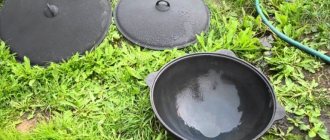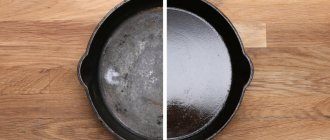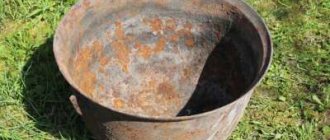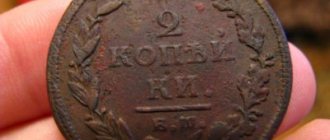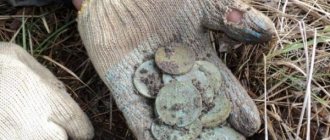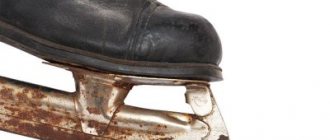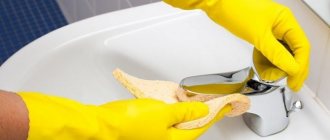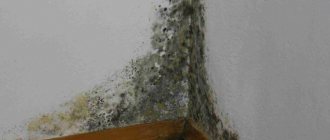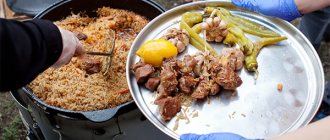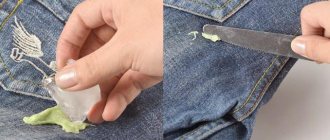A cauldron is a large cast iron pan in which you can cook almost any dish, preserving all its beneficial properties, and which will also come out tasty and aromatic. But, despite its unique qualities, the cauldron is subject to one major drawback - it can rust. To find out how to clean rust from a cauldron, you should read the material presented below.
A cauldron is a large saucepan or kettle, suitable for cooking both on the stove and over an open fire.
Why does a cast iron cauldron become rusty?
There are several reasons why the walls and bottom of a cauldron may corrode, and all of them are associated with improper care of the cookware. When purchasing such outlandish utensils, you need to have a complete understanding of all aspects of care.
If stored improperly and rarely used, kitchen utensils will inevitably rust.
Cast iron becomes rusty due to its porous structure, which allows moisture to accumulate and cause deterioration. Iron is also often added to the alloy during production. Incorrect processing during first use, namely lack of calcination, creates a risk of rust.
A cast iron pot is found in almost every home and is used periodically.
Preventive actions to prevent corrosion
Corrosion can only be prevented by proper storage and handling. After purchasing, the cauldron must be calcined. There are two main methods - on the stove and in the oven.
Be sure to coat the walls and bottom with oil. And heat until the oil has completely evaporated, after which the cauldron should be allowed to cool. If the kit includes a lid, it also needs to be calcined.
The cauldron must be fired before first use.
The other method is only suitable for the stove. You need to pour 1 kg of salt into the cauldron (or more, depending on the volume). Then keep it on the fire until the salt darkens.
Be sure to cover the pot, as the heated salt may “shoot” during the process.
These tips will help you avoid corrosion over time. Careful handling is also a guarantee that the cauldron will last longer without any signs of rust. It is important to remember that the main cause is moisture - you just need to wipe the dishes dry.
How to clean a cast iron cauldron from rust inside
Many owners of cast iron cauldrons are faced with the question of how to remove rust from a cast iron cauldron so that it becomes clean and beautiful again? Many methods have been invented, and they can be divided into two categories: folk remedies, the ingredients for which everyone has in their kitchen drawers, and the use of special chemicals that are sold in hardware stores. Each has both its pros and cons. Only the owner of the dish can decide how to act.
There are many methods on how to clean a cauldron from rust with a minimum of cost.
We use household chemicals
Since the cauldron is not a Teflon frying pan, with a delicate and sensitive coating, it can be cleaned using a variety of methods, including the use of abrasive powders and hard brushes. The procedure is as follows: apply a little powder to a sponge or washcloth, then rub it into places where rust stains accumulate. The cleaned cauldron is thoroughly rinsed and then calcined over a hot fire. This is necessary to prevent new corrosion.
Cauldrons rust if improperly stored and rarely used.
How to clean a cauldron with sandpaper
Sandpaper is quite capable of coping with this kind of problem. It’s better to take two types: large and small. After processing with coarse sandpaper, the rust will turn into dust, which just needs to be washed off with water. For final cleaning, you should rub the walls with fine-grained paper. You need to work carefully so as not to breathe in microparticles; you can even put a gauze mask on your face and comfortable gloves on your hands.
You must follow the instructions to avoid unpleasant consequences.
How to remove with a drill
A rather extravagant way to clean a cast iron cauldron is to cut off the rust with a drill. This method is a bit similar to the previous one because mechanical force will also be used. It is imperative to follow safety precautions. After the procedure, the dishes must be ignited.
Be sure to follow safety precautions when working with a drill.
How to wash with glue and soap
To remove rust this way, you need to prepare. Firstly, you need a large container into which the entire cauldron can fit. If the boiler is larger than ten liters, then most likely it is better to clean it in another way. But a cauldron with a small capacity will do.
Glue and soap help keep the cauldron in good shape.
So, the washed cauldron is placed in a large container filled with water, into which a bar of laundry soap is rubbed and a bottle of silicate glue is poured. The mixture is put on fire and boiled for several hours until a paste forms. After this, the solution is cooled and drained. Once covered with a light film, the cauldron can begin to be cleaned. Soot and rust should come off with it under an ordinary soft sponge. The remains are washed away. The appearance is again pleasing to the eye.
After this treatment, the carbon deposits will come off with regular washing with a soft sponge.
We apply grinding
In order not to have to worry about cleaning at home, you can take the cauldron to the nearest car service center, where they will clean it with a grinding machine (not everyone has such a unit at home). After the procedure, everything necessary is done with the dishes: washed, dried and calcined.
If home cleaning fails, it is recommended to remove the corrosion using a sander.
Cleaning with vinegar
Vinegar is a unique remedy for a wide variety of stains. With its help you can put any thing in order, including a cast iron cauldron.
Pour vinegar, heavily diluted with water, into a large basin. Place the cauldron there for several hours.
There are different combinations of vinegar and other substances that together make cleansing even faster and more effective. The simplest solution is to boil three hundred milliliters of liquid, and the rust will disappear, and the cauldron will again have a glossy shine with black sides.
Afterwards, you can clean the utensils using regular river sand to remove softened carbon deposits.
If you add a spoonful of soda, the process will speed up (everyone knows what reaction is caused by the combination of sodium carbonate and acid).
It is possible to add table salt.
During boiling, you need to move away. If this happens in the kitchen, then you need to open the windows and close the door tightly, because vinegar fumes are harmful to health.
A mixture of soda and salt
These two substances are reliable companions of a good housewife. Despite the abundance of modern detergents, they are widely used in the kitchen because they remove any dirt well, are cheap and harmless.
Afterwards you just need to wash the cauldron and heat it with oil.
To clean, take an equal amount of soda and salt, fill it with water and heat it up. The boiling mixture will remove rust after two to three hours. Depends on the degree of corrosion.
If rust stains have just appeared, they can be removed with a sponge and a very small amount of the mixture.
How to clean a cauldron at home?
Despite its unattractive appearance, rust, at least in the initial stages of its appearance, will not cause much harm. But, of course, the cauldron needs to be cleaned. How to do this at home? Naturally, with the help of improvised means that are found in almost any home.
Among folk methods, a common vegetable that can be found in every refrigerator is in demand. Raw potatoes do an excellent job of removing a slight rusty coating.
A 1:1 mixture of vinegar and water will help get rid of a thicker layer - immerse the cauldron in it for 3-4 hours. After soaking, mix coarse salt with vegetable oil, and wipe the walls of the dishes with this mixture.
But the most famous method is digestion. It is the most complex, but also universal. Boiling will help get rid of not only rust, but also soot, carbon deposits, and everything that spoils the walls of the dishes. For digestion, a mixture of laundry soap and office glue is used. You need a whole bar of soap, 100 g of glue is enough. All this is dissolved in water, a cauldron is placed in the solution (it needs to be completely immersed), and cooked for about 4 hours over low heat. After such cooking, all carbon deposits and rust can be easily removed with a regular dishwashing sponge.
Is there a lot of rust and has it penetrated deep? Sandpaper and cola will help
Pepsi, Coca - not so important, both drinks contain phosphoric acid, and it is this that eats away rust. Immediately the walls are treated with sandpaper, after cleaning the cauldron is completely immersed in cola, the liquid is brought to a boil and turned off
The dishes are not removed from the cola until it cools down.
After each cleaning method, the cauldron is thoroughly washed with water, wiped with a dry towel and be sure to be calcined with oil.
What products should not be used to clean a cauldron?
Although the boiler is quite wear-resistant and insensitive to mechanical stress, there are some prohibited cleaning methods.
It is prohibited to use metal objects to avoid scratching the surface while mixing food.
It is strictly forbidden to scrape the surface with forks, knives or other hard objects that leave scratches. It is not recommended to pour cold water into a hot cauldron, because temperature changes may damage the coating.
It is not recommended to rinse the cauldron immediately after cooking - you need to wait until it cools down.
You should not use hazardous, strong-smelling detergents. They are able to penetrate into the pores of cast iron, from which it is very difficult to wash them out.
Material matters
The material from which the cauldron is made is of great importance when choosing a cleaning method. The most common option is cast iron. For such a container, the use of household chemicals is strictly contraindicated. The abrasives used in it destroy the protective film of burnt fat, and therefore the coating deteriorates very quickly.
The second most common type is aluminum alloys. They can be washed with mild household chemicals, but abrasives, acids and alkalis cannot be used.
The owner of a copper cauldron is a huge rarity in itself. You can clean it with anything: household chemicals, abrasives, and folk remedies. Anything will do.
Fact!
Recently, cauldrons with non-stick and enameled coatings have appeared on the market. They are not real. Cooking with them over fire is risky. The coating may burst.
Prevention of corrosion and care of a cast iron cauldron
Any utensils need careful and responsible handling. If, after cooking, the cauldron was not washed well, not wiped dry and put in a cupboard, then it is not surprising that rust will soon appear in it.
Do not store the cauldron in a damp place. After washing, the utensils must be thoroughly dried and only then put away for storage.
To prevent this from happening, you must follow a number of rules:
- Before the very first use, the cauldron is heated. This makes it stronger, food will not stick to the walls, and it will be easier to clean.
- After washing the cauldron, you should dry it well with a soft cotton towel, and leave it in the open air for a while to ventilate and dry better.
- Important: the boiler must be cleaned immediately after cooking. Then you won’t have to deal with dried-on food residues and spoil the surface with harsh shuffles.
- Do not use aggressive agents or steel wool: they destroy the non-stick layer. An ordinary kitchen sponge and odorless liquid soap are sufficient for effective care.
- It is not recommended to pay attention to advertised anti-rust products. All of them contain harmful substances that only worsen the situation. It is much better to use “grandmother’s” remedies.
- Just emerging, barely noticeable rusty spots can be easily removed with the juice of an onion or raw potato.
Care Tips
After processing a new cauldron, you must adhere to the rules for caring for it. They are as follows:
- After cooking, it is better to transfer hot food to another container.
- Be sure to thoroughly clean the cast iron from food residues and rinse without detergents.
- Wipe dry and put back in place.
The dishes should not be wet during storage; it is advisable to wipe them with a dry cloth from time to time. When using aggressive detergents, the non-stick properties may be lost, so you can treat the product with oil again. Cast iron cookware is very reliable and if you know how to store the cauldron correctly, it can last forever.
It is important to remember that annealing is useful not only for new cookware. The procedure is recommended if there are burnt food residues on the cauldron.
If abrasive products are used, the dishes must be burned, then a layer of oil must be built up.
How to store a cast iron cauldron so that it does not rust
There are very few rules to follow here.
- After each cooking, the cauldron is washed, dried and placed in a secluded place;
- Ideally, it is best to put the dishes away in a spacious cabinet with doors: it is dry and clean, but dust from the street does not penetrate there;
- The room should also be dry and well ventilated. A basement, garage, shed or some kind of cluttered storage room is definitely not suitable.
- It is recommended to keep the lid separately.
- Do not place other utensils inside: water may leak from them.
Daily care rules
We can only talk about daily care if the cast iron cookware is used every day
If the housewife has a lot of frying pans, which she uses according to her mood and need, it is important to ensure proper storage of cast iron utensils
Enamel coated
Frying pans and cauldrons coated with a layer of enamel are excellent for cooking and long stewing. The enameled layer adheres firmly to the cast iron, so as not to chip or destroy it, the following care rules should be observed:
- do not place hot dishes under cold water;
- do not clean with powders with abrasive properties;
- after removing the food, pour warm water into a cold dish, add mild soap, leave for 20-60 minutes, wash with a sponge, and dry;
- If the burnt food does not come off, fill the cauldron with water, add liquid soap and a spoonful of soda and boil for several minutes.
Enamel coating requires less maintenance than plain cast iron
It is important not to chip it, not to peel off the burnt remains with a knife, and wait for them to soften in the water on their own. Too aggressive exposure leads to a gradual thinning of the enamel layer, the dishes lose their presentable appearance, but not their properties
Without cover
The main advantage of a cast iron frying pan is the formed oil layer on the surface, which prevents food from burning. When cleaning, the main task is to preserve this impregnation. Therefore, you need to handle cast iron cookware as follows:
- remove food from the pan immediately after cooking;
- do not remove food debris with a knife, abrasives, or metal mesh;
- do not use strong fat solvents for dishes;
- do not soak pans with soap solutions for a long time;
- Do not boil water with soap.
Cast iron is a porous material. The more often you cook in a frying pan, the better it becomes, the walls become shiny. If the frying pan is used regularly, no aggressive chemicals are used when washing, and it is not stored in a damp place, there is no need to lubricate it with oil after wiping.
Preparation and use
After purchase, a cast iron cauldron, like a frying pan, cannot be used immediately. You need to bake the pan to remove any remaining machine oil and create a non-stick layer. First you need to wash the container on each side with warm water, wipe it and heat it on the stove. When the smoke stops, pour in 0.4-0.7 liters of vegetable oil and reduce the heat.
Rotate the cauldron so that the oil gets on the walls and is evenly distributed inside. Perform the procedure when the surface becomes slightly reddish, but not completely red. Then cool the dishes, drain the oil and wash them in warm water without soap or other products. When the water has drained, wipe with a dry, clean cloth or paper towel. For more information on how to season cast iron cookware, see here.
To cook in a cauldron, you need to follow several principles. First you need to render the fat (lard) or vegetable oil. Then the onion is thrown in and fried until it turns bronze. It draws out unpleasant odors from cast iron. After frying, remove the onion and prepare the desired dish.
The first manipulations, namely frying, are performed over high heat. Then add spices and other ingredients, which are simmered under the lid and over low heat for quite a long time. This principle is suitable for preparing any dishes. In order for the cookware to serve for a long time and retain its original properties and appearance, you need to properly care for the cast iron cauldron.
How to wash a cauldron after cooking
Dishes made of porous alloys do not like aggressive cleaning. The pores become clogged with detergent; the surface will have to be rinsed with running water for a long time. The oily non-stick layer is destroyed.
How to wash a cauldron? After cooking, food is placed in another container; it cannot be stored in porous metal; the dishes will acquire an unpleasant odor. After pilaf and other dishes that are well steamed, it is enough to remove any remaining food from the vessel. After this, just wash the utensils with warm water without detergents and wipe well. If this method fails to achieve the expected result, pour water into a massive utensil to 1/3 of the depth, bring to a boil, cover with a lid. All particles of fat can then be easily removed with a foam sponge.
To wash an aluminum cauldron, you can use ordinary dishwashing detergents that do not contain aggressive acids and alkalis.
Aluminum utensils are easier to clean. To wash it, you can use ordinary dishwashing detergents that do not contain aggressive acids and alkalis. Previously, the burnt areas are lubricated from the inside with a paste of salt or mustard powder. The outside of a cauldron used on an open fire is cleaned of soot using traditional methods:
- River sand with grass;
- Coarse salt;
- Ash.
At home, the cauldron is pre-soaked in a soapy solution and completely immersed in a large container. After this, clean well under hot water, rinse, and wipe dry.
It is best to wash a cast iron cauldron with hot water without soap.
How to wash a cast iron cauldron? Hot water without soap is best. If it is not possible to remove all contaminants with water, the correct method of cleaning cast iron involves gentle washing while preserving the oily protective layer:
- Mild detergents;
- Dry mustard;
- Soda.
It is necessary to restore the anti-corrosion layer after washing - just wipe the inside of the cauldron with an oiled napkin or cloth.
With proper care, the cauldron will last for years.
It is important to protect the vessel from excess moisture: rust stains form on cast iron; Harmful fungi multiply on the aluminum surface. For long-term storage, it is better to wrap the vessel in cotton or linen cloth
With proper care, the cauldron will last for years. Which dishes to choose is up to everyone to decide for themselves. Aluminum utensils are lighter than cast iron. You can take it with you outdoors. Cast iron retains heat longer, food simmers in it and becomes tasty. You learned how to clean a cauldron quickly and correctly. Take care of your dishes by following our tips and delight your loved ones with delicious pilaf and other dishes!
